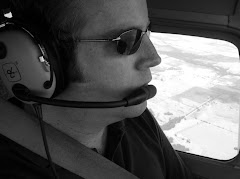
Instrument checkride passed.
Upon rising at 0530, I check the weather and see the break I've been waiting for... DFW reporting a scattered layer at 3,000. Finally good enough to fly.
I meet checkride examiner K.B. at the airport and preflight N756A, a 2000 model Seminole. The plan is to simulate a flight plan to Houston, then divert after takeoff to Dallas Executive Airport to shoot an ILS approach (single engine), go missed, fly a DME arc, then to Grand Prairie Airport for a GPS approach, go missed again, hold at the published missed procedure, then back to Arlington for a VOR-DME approach and land... all while under the Foggles ("under the hood", as they say).
Shortly after takeoff, I climb to 2,500 feet and go under the hood. K.B. asks me some questions about our plan to Houston, which I answer, and he asks me to take him to Dallas Executive. Along the way, he asks me to descend to 2,000 feet because we're in a thin cloud layer. I do so, and start to consider how this descent will affect my approach. After some quick internal debate, I decide that it can't be done, since the approach needs to be started at 2,300 feet and we need to stay 500 feet below the clouds to remain in VFR. He agrees, and asks me to take him to Grand Prairie instead. The nerves I was experiencing disappear, stoked that I made a good decision at a critical time. Feeling kinda pilot-y all of a sudden!
On the way to Grand Prairie, K.B. takes the controls and asks me to put my head down for an unusual attitude recovery. I can feel the plane dip and weave for about 30 seconds, then when he tells me to recover I look at my instrument panel to find us banked sharply to the left and my airspeed increasing rapidly... we're diving. I cut the throttles, go wings-level, and recover.
We've been grounded for 3 days, which means that everyone else in the area has been grounded for 3 days. The appearance of blue sky after a few days of weather is like ringing the aviation dinner bell. I'd never seen this much traffic in the area before. The Seminole is equipped with TIS (Traffic Information System), which will alert us of traffic within 2 miles of our location and provide heading and altitude of that traffic. Through this 90-minute flight, we got "pinged" about 10 times, each time having to go visual (removing the Foggles) to find the aircraft in our area and make sure we don't collide. It threw a wrench into some of my flows, but I maintained well and K.B. seemed very understanding.
Shot the approach at Grand Prairie with a partial panel... a piece of paper blocking my view of the attitude and heading indicators, so my primary instrument becomes the Garmin 430. Went missed and flew the hold (flying in an oval pattern at a specified place and altitude) over Joe Pool Lake as published, then left the hold for the ILS approach into Arlington's runway 34. I kept waiting for K.B. to cut my throttle, and I could see his hand twitching a bit as if he meant to do it, but I think the heavy area traffic kept him from doing it. I go missed shortly before landing, fly south again for a while, then re-position for the VOR-DME approach into Arlington. Nailed it.
K.B. is silent as I taxi back to the main ramp, where I park, complete my shutdown/termination checklists, and finally...
"Congratulations, you passed this examination."
Flight partner Daniel and instructor Aaron meet me at the ramp. I hand the plane over to Dan and 90 minutes later, he also has his instrument rating.
As an instrument-rated pilot, I can now fly outside of Visual Flight Rules. In other words, I can bust clouds!
With instrument rating in tow, tomorrow I start "302", which is ATP code for right-seat flight training and crew resource management. Since I'll be flying with another student instead of an instructor for the next 75 flight hours, this training will help us manage our shared duties and identify individual responsibilities while flying as a team. Time to start acting like a pilot!


No comments:
Post a Comment